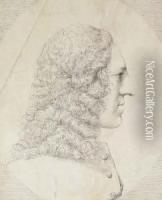Carlo Francesco Ponzone Paintings
Carlo Francesco Ponzone was an Italian painter of the late Renaissance period, hailing from Cremona, which was a significant center for music and the arts during the 16th century. While not as widely recognized as some of his contemporaries, Ponzone played a role in the vibrant cultural scene of Northern Italy during a period that bridged the late Renaissance and the early Baroque.
Ponzone was born in 1553 in Cremona. Little is known about his early life and training, but it is likely that he was part of the fertile artistic environment of Cremona, which was also the hometown of the more famous painter Sofonisba Anguissola. As was common in the Renaissance, artists often honed their skills as apprentices in the workshops of established masters. Through this system, Ponzone would have learned the fundamentals of drawing, composition, and the handling of color.
His work is characterized by the Mannerist style, which was prevalent in the late Renaissance. Mannerism is known for its artificiality, elongated proportions, and a tendency towards complexity and tension in composition over the balance and harmony that characterized the High Renaissance. Ponzone’s paintings often featured religious subjects, a common theme for the time, as the Counter-Reformation spurred the creation of art that was meant to inspire and educate the faithful.
The details of Ponzone’s career are somewhat obscure, and few of his works have been clearly attributed to him. This is partly due to the overshadowing fame of his contemporaries and the scant documentation that survived over the centuries. However, it is believed that his paintings reflected a competent grasp of the Mannerist style and contributed to the rich tapestry of Renaissance art in Northern Italy.
Ponzone died in 1608 in Cremona. Despite the lack of widespread recognition, his life and work embody the journey of a regional artist in Renaissance Italy, contributing to the cultural heritage of his time. The scarcity of information and surviving works has left Ponzone as a somewhat enigmatic figure, representative of the many skilled but lesser-known artists of the era whose contributions to the arts are appreciated more by specialists and local historians than by the general public.
